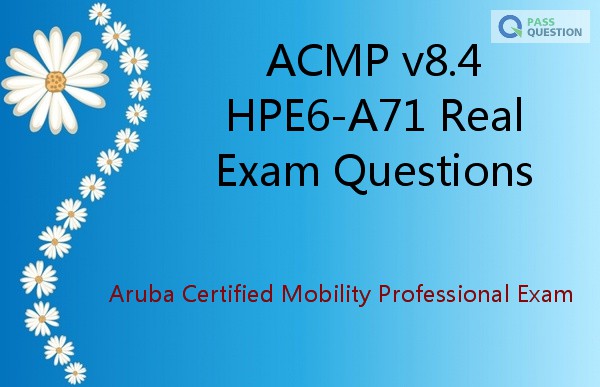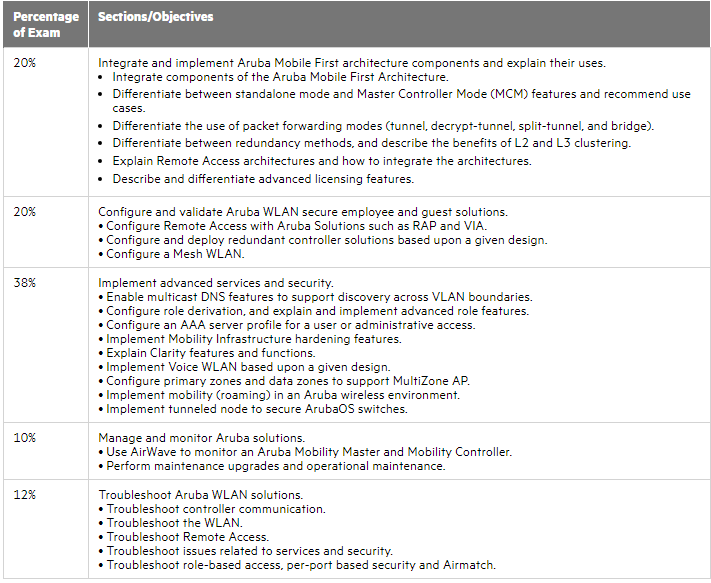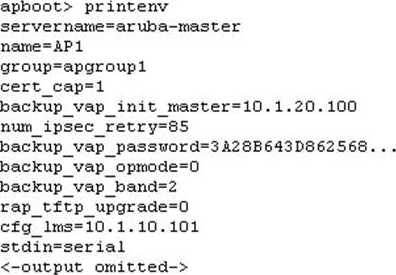ACMP v8.4 HPE6-A71 Real Exam Questions - Aruba Certified Mobility Professional Exam
HPE6-A71 Aruba Certified Mobility Professional Exam is qualified for ACMP v8.4 certification. To help you pass your HPE6-A71 exam, PassQuestion provides ACMP v8.4 HPE6-A71 Real Exam Questions which contain 60 questions and answers for you to practice, it will make you feel easy to take your HPE6-A71 exam and get your ACMP v8.4 certification easily in your first time.

ACMP v8.4 Certification HPE6-A71 Exam Overview
HPE6-A71 exam tests your skills with the WLAN design, deployment, and troubleshooting of Aruba Mobile First Network Solutions in complex highly available campus and branch environments. It also tests your ability to configure specialized applications, management, and security requirements for a WLAN such as UCC Voice and advanced security features.

Typical candidates for this exam are networking IT professionals with a minimum of two years of advanced-level implementation experience with Aruba WLAN solutions and a minimum of three years of experience with wired LAN infrastructure and switching and routing technologies.
ACMP v8.4 HPE6-A71 Exam Topics Covered In Aruba Certified Mobility Professional Exam

View Online HPE6-A71 Free Questions Selected From PassQuestion ACMP v8.4 HPE6-A71 Real Exam Questions
1.An administrator deploys an AP at a branch office. The branch office has a private WAN circuit that provides connectivity to a corporate office controller. An Ethernet port on the AP is connected to a network storage device that contains sensitive information. The administrator is concerned about sending this traffic in clear-text across the private WAN circuit.
What can the administrator do to prevent this problem?
A. Enable IPSec encryption on the AP's wired ports.
B. Convert the campus AP into a RAP.
C. Redirect the wired port traffic to an AP-to-controller GRE tunnel.
D. Enable AP encryption for wired ports.
Answer: A
2.An administrator needs to modify a VAP used for a branch office RAP. The VAP's operating mode is currently defined as backup and uses tunnel mode forwarding. The administrator wants to implement split-tunnel forwarding mode in the VAP.
Which WLAN operating mode must the administrator define for the VAP before the tunnel forwarding mode can be changed to split-tunnel?
A. Trusted
B. Always
C. Persistent
D. Standard
Answer: D
3.The administrator expects the AP to connect to a cluster, but the AP fails to connect.
The administrator examines the configuration of an AP from apboot mode shown in the exhibit.

What can the administrator determine about the configuration of the AP?
A. The AP is configured to terminate on a Mobility Controller in a cluster.
B. The AP is configured as a RAP to terminate on a stand-alone controller.
C. The AP is configured as a RAP to terminate on a Mobility Master.
D. The AP is configured to terminate on a non-cluster Mobility Controller.
Answer: D
4.An administrator creates service-based policies for AirGroup on the Mobility Master (MM). The administrator can define location-based policy limits based on which information?
A. controller names, controller groups, and controller Fully Qualified Domain Names (FQDNs)
B. AP names, AP groups, controller names, and controller groups
C. AP Fully Qualified Location Names (FQLNs) and controller Fully Qualified Domain Names (FQDNs)
D. AP names, AP groups, and AP Fully Qualified Location Names (FQLNs)
Answer: D
5.An administrator supports a RAP at a branch office. A user's device that is attached to the Ethernet port is assigned an 802.1X AAA policy and is configured for tunneled node.
How is the user's traffic transmitted to the corporate office?
A. It is not encapsulated by GRE and not protected with IPSec.
B. It is encapsulated by GRE and protected with IPSec.
C. It is not encapsulated by GRE but is protected with IPSec.
D. It is encapsulated by GRE and not protected with IPSec.
Answer: B
6.An administrator creates a user role that department A in a company uses. Various other roles exist for other departments. All employees connect to the same ESSID, which authenticates to an external AAA server.
How should the administrator configure the controller to assign the appropriate roles to the employees?
A. Implement default roles.
B. Implement user roles.
C. Implement AAA profile roles.
D. Implement server-derived roles.
Answer: B
7.An administrator implements two redundant Aruba Mobility Masters (MMs).
Which protocol should the administrator use to detect a failure in a single subnet?
A. PAPI
B. VRRP
C. SNMP
D. IPSec
Answer: B
- TOP 50 Exam Questions
-
Exam
All copyrights reserved 2025 PassQuestion NETWORK CO.,LIMITED. All Rights Reserved.

